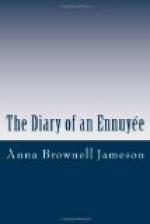There is no opera at present, but we have visited both the other theatres. At the San Luca, they gave us “Elizabeth, the Exile of Siberia,” tolerably acted: but there was one trait introduced very characteristic of the place and people: Elizabeth in a tremendous snow storm, is pursued by robbers; and finding a crucifix, erected by the road side, embraces it for protection. The crucifix flies away with her in a clap of thunder, and sets her down safely at a distance from her persecutors. The audience appeared equally enchanted and edified by this scene: some of the women near me crossed themselves, and put their handkerchiefs to their eyes: the men rose from their seats, clapped with enthusiasm, and shouted “Bravo! Miracolo!”
At the San Benedetto we were gratified by a deep tragedy entitled “Gabrielle Innocente,” so exquisitely absurd, and so grotesquely acted, that the best comedy could scarcely have afforded us more amusement,—certainly not more merriment. In the course of the evening, coffee and ices were served in our box, as is the custom here.
With Mrs. H—— this evening I had a long and pleasant conversation; she is really one of the most delightful and unaffected women I ever met with: and as there is nothing in my melancholy visage and shrinking reserve to tempt any person to converse with me, I must also set her down as one of the most good-natured. She talked much of Lord Byron, with whom, during his residence here she was on intimate terms. She spoke of him, not conceitedly as one vain of the acquaintance of a great character; nor with affected reserve, as if afraid of committing herself—but with openness, animation, and cordial kindness, as one whom she liked, and had reason to like. She says the style of Lord Byron’s conversation is very much that of Don Juan: just in the same manner are the familiar, the brilliant, the sublime, the affecting, the witty, the ludicrous, and the licentious, mingled and contrasted. Several little anecdotes which she related I need not write down; I can scarcely forget them, and it would not be quite fair as they were told en confiance. I am no anecdote hunter, picking up articles for “my pocket book.”
* * * * *
A little while ago Captain F. lent me D’Israeli’s Essays on the Literary Character, which had once belonged to Lord Byron; and contained marginal notes in his hand-writing. One or two of them are so curiously characteristic that I copy them here.
The first note is on a passage in which D’Israeli, in allusion to Lord Byron, traces his fondness for oriental scenery to his having read Rycaut at an early age. On this Lord Byron observes, that he read every book relating to the east before he was ten years old, including De Tott and Cantemir as well as Rycaut: at that age, he says that he detested all poetry, and adds, “when I was in Turkey, I was oftener tempted to turn mussulman than poet: and have often regretted since that I did not.”




